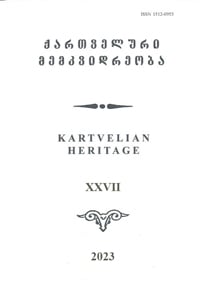FROM THE 18TH CENTURY REGARDING A GEORGIAN CAPTIVE SOLD IN EGYPT
DOI:
https://doi.org/10.52340/PUTK.2023.27.25Keywords:
sale of captives, Georgian captives in EgyptAbstract
The document is housed in the National Center of Manuscripts of Georgia and is written in the Mkhedruli script on a scroll. It begins with an artistically painted Kantsili and a cross. There is a small area of damage on the edge of the right side, likely caused by moisture. The calligraphy is exquisite. At the bottom, there are two seals: one rectangular seal with the inscription ‘Parsadan’ and another square, beveled seal with the inscription ‘Servant of God, Milakhvari Luarsab’. Both individuals represented the feudal house of Machabeli. Among them, Parsadan Machabeli is mentioned in many deeds from the second half of the 18th century. For instance, a deed bears the following vertical inscription on the left side: ‘I, Revaz Machabeli, certify this deed (then one character is lost). I did not have the seal. This is my writing.’ The last word of the inscription is illegible, although it is highly likely to be ‘Revaz’. In addition to the complicated geopolitical situation, mainly driven by the IranOttoman conflict in the Caucasus, human trafficking became an even more significant problem for our country in the late Middle Ages. The Ottoman Empire’s dominance on the Black Sea facilitated widespread ‘purchase of captives‘, where people abducted from Georgia were sold in Ottoman or Syrian slave markets. The country faced a demographic catastrophe, and both Georgian and foreign sources document these harsh realities of the late Middle Ages. This distressing trend of selling people extended to almost every corner of our country, as it was deemed a profitable business. Unfortunately, even representatives of the feudal aristocracy supported it. ‘Purchase of captives‘ appears to have been prevalent in Samachablo as well, with members of the feudal house of Machabeli also participating in this trade. The presented document contains fascinating information about the sale of Bezhan Kasradze from Samachablo to Misri (Egypt). It appears he was ‘lost from Leki’. Kasradze, kidnapped by the Leks residing in the stronghold of Machabeli, ended up in Egypt. As known, ‘Lekianoba’ posed one of the unsolvable problems in Kartli-Kakheti in the second half of the 18th century. There was no exception in this respect, the peasants who were kidnapped often managed to free themselves, leading to a decision by Erekle II in 1765. This decision granted escaped serf-peasants the right to live freely without their former masters having any claim over them. These liberated peasants could choose to continue their lives independently or select a new owner. Most of the peasants released from captivity became khaso or church serfs, with only a small portion retaining their freedom, often opting to re-subjugate due to their vulnerable circumstances. It is evident from the presented document that Bezhan Kasradze, abducted from the Leks and later sold in Egypt, sent money (several tumnis of gold) to his family members. The Machabelis had mortgaged three properties with Gorel Amiraghashvili in Variani, and Paata Kasradze’s brother Bezhan redeemed the Machabelis’ estates with the money sent from Egypt. With the money sent by Bezhan Kasradze, who was sold in Egypt, his housemates also used the funds to construct a defensive tower in Kemerti. While the document does not provide details, there is still a standing tower in Kemerti known as Kasraant Godol. This tower was built by the Kasradzes of Kemerti to protect themselves from the Leks.

